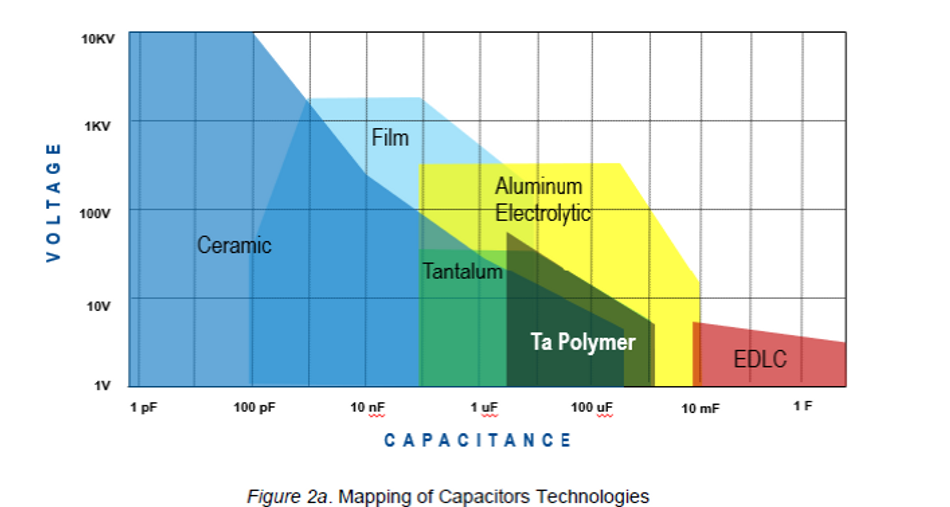Flexible Supercapacitors Unlock New Opportunities
A change in form enables a discrete and distributed network of power storage.
The pace and scope of technological innovations today is very exciting. Computers, cameras and even cars double their performance approximately every two years. This is thanks to the rapid advancements of semiconductor technologies, which change so rapidly, a whole new world is created every decade or so.
One impediment to bringing new products and technologies to market has been the alarming lack of innovation in energy storage technologies. Progress for energy storage technologies like batteries and supercapacitors lag woefully behind the breathtaking rate of change in semiconductor technologies.
This is all about to change. But first a very brief history of capacitors.
History of Capacitors
Flashback to 1746. A capacitor is a device that stores an electric charge. This was first demonstrated by the Leyden Jar, invented by Ewald Jurgen von Kleist at the University of Leyden in Holland. The Leyden Jar is a glass jar wrapped with one piece of metal foil on the outside and another, separate piece of metal foil on the inside. When the foil was connected to an electricity source and then disconnected, scientists noticed that the jar would store the charge even after the source was disconnected. This means you could save electricity after it was generated for later use.
While there was not much use for such a device at the time, besides storing the electricity collected from Benjamin Franklin’s kite-flying experiment, this was the origin of the function of capacitors. It was not until the 1830s when Michael Faraday started to experiment with the materials that go inside the capacitor’s plates to study the impact of its energy storage capability.
With the exception of supercapacitors, the capacitors we still used today were invented in the early 1900s. Different technologies allowed for different power density, peak voltage and frequency characteristic. This lead to the development of ceramic, aluminum electrolytic, tantalum, polymer, and eventually supercapacitors (Figure 1).
Introduction to Supercapacitors
Supercapacitors, also known as ultracapacitors or electric double layer capacitor (EDLC), leverage two energy storage mechanisms. The first, like all capacitors, is the electric field. The second is from energy storage materials and chemistry placed between the plates, inside the electric field. Supercapacitors come in a variety of sizes from 0.1F to over 1000F, which is a significant amount of energy storage in the realm of capacitors. The synergy of the electric field and energy storage chemistry enables supercapacitors to charge and discharge a lot of energy very quickly. These energy storage materials have become a focus area for researchers.
The ability to charge and discharge a lot of energy very quickly secures supercapacitors’ place in the future, being critical to the mainstream adoption of a variety of technologies enabling Cleantech, Wearables, and Internet of Things (IoT) applications among others. The ability to charge and discharge quickly points to supercapacitor’s low internal resistance and high-power density, its chief characteristic. In addition to this nearly instantaneous ability to absorb and deliver power, supercapacitors have a very long cycle life. These features make them ideal for applications where short bursts of power are needed. Common examples include providing peak power to complement a battery or turning on a large electric motor, peak load leveling for high quality audio systems or power sensitive communication devices, backup power to telecom equipment or to give electronics enough time to safely shut down, and for collecting energy from intermittent sources such as indoor solar cells.
Academic and industry leaders have largely focused on improving the energy storage materials that go inside of supercapacitors to increase their performance, specifically increasing energy and power density. This is important work but is not the only avenue for innovation to improve supercapacitors.
Until now, supercapacitors have generally clung to the basic form all capacitors have come in for over 250 years. Supercapacitors today come in cylindrical or rectangular shapes that are installed on circuit boards, where space is highly valuable. While it is important to improve the materials and chemistries that supercapacitors rely on, form factor improvements so that supercapacitors can be used in places less restrictive than circuit boards is important too.
The Opportunity in Changing the Shape of Supercapacitors
What engineers need are supercapacitors that are as flexible as a wire, allowing for energy storage in unexpected places — such as inside of wiring harnesses, power cords, and wearables. Capacitech Energy is a high-tech energy storage company that is freeing supercapacitor technologies from their restriction to two-dimensional circuit boards. Capacitech is reimagining energy storage systems by innovating the shape that energy storage products, like supercapacitors, come in.
Capacitech’s Flexible Supercapacitor Innovation
Capacitech’s Cable-Based Capacitor (CBC) is a radically new, flexible, and wire-like supercapacitor optimized for space to help miniaturize electronics and complement power sources lacking peak-power capability such as batteries and energy harvesting devices. The CBC gives designers more space, opportunity to add new features, and design flexibility to meet their customers’ needs.
Many circuits have a working voltage above that of a single supercapacitor, which is typically 2.7 volts. This requires supercapacitors to be stacked into a bank, which takes up significant space in the system or on the circuit board. This is the case for most high-value supercapacitor applications, like renewables and electric vehicles. In these kinds of applications, a lot of supercapacitors are required to be connected in series and parallel, which leads to negative engineering tradeoffs like:
1. Increasing bulk
2. Removing features
3. Sacrificing performance
Capacitech’s innovative CBC leverages its physically flexible form factor to eliminate the need to make these painful tradeoffs. This is because, like no supercapacitor before it, the CBC can be routed through areas where space is available on the circuit board or placed off the circuit board and integrated into other parts of the product or system’s infrastructure instead.
Internet of Things Use Case
One attractive use case for this wire-like supercapacitor is in the IoT space. Limited by a low cycle life, battery powered IoT devices have a short service life. The cost of frequently replacing these batteries every 2-5 years is staggering. A technician can expect to spend 20% of their day changing batteries for a typical IoT installation. Energy harvesting technologies, such as a solar cell, on their own are extremely limited due to their low peak-power capability; however, they can be paired with a high-powered supercapacitor to serve as an alternative to batteries. This technique is growing in popularity, but also forces design substitutions to free up space on the IoT device’s PCB to make room for supercapacitors. Instead of using space on the PCB, the cable form factor can be connected with the wires coming from the energy harvesting device. Capacitech’s supercapacitor features 3F of capacitance, can be charged at low currents, and is capable of providing over 1A of current to the load. The result meets the power requirements of Bluetooth, Wi-Fi, LoRa, and even cellularly connected IoT devices. Economically, it could reduce the cost of ownership for the end user (by replacing costly batteries) by ~25% and returns ~33% of the space on the IoT device’s PCB to the design engineer for miniaturization or new features.
Can Wire-Like Supercapacitors Help Batteries?
While both energy storage components, batteries and supercapacitors are optimized for different functions and designed to serve a different purpose. Supercapacitors are designed to deliver a lot of energy (which is power) quickly and respond to fluctuations in power. This ability is due to the supercapacitor’s high-power density. Batteries are designed to deliver a smaller, constant stream of energy over a long period of time. This ability is due to the battery’s high-energy density. A supercapacitor can deliver well over 10x the amount of power compared to a battery, while a battery can deliver well over 10x the amount of energy compared to a supercapacitor.
Supercapacitors complement batteries by protecting them from stress that comes from surge currents and power fluctuations. Batteries have greater energy density, but supercapacitors can meet peak power needs better. Thus, when the batteries and supercapacitors are combined, one discovers better performance in a smaller space. An ideal energy storage system should feature both batteries and supercapacitors. With Capacitech’s CBC, the supercapacitors can be integrated into the infrastructure of the product or system, rather than compete with batteries for space. This way, engineers and designers can pack the maximum level of high-power density and high-energy density energy storage components in their products.
The CBC’s ability to integrate into wiring harness and to complement batteries makes it a perfect solution for both gas and electric powered automotive vehicles, as well as several applications in renewable energy systems.
The Future Features Flexible & Seamlessly Integrated Supercapacitors
While the value added by supercapacitors is known and well documented, finding the physical space to add supercapacitors is another challenge to be overcome with form factor innovations. With the CBC, designers can build a discrete and distributed network of supercapacitors to help miniaturize electronics and complement batteries; whether that is integrating supercapacitors into the leads of an indoor solar cell for an Internet of Things application, the wiring harness of an electric vehicle, or the photovoltaic wiring of a solar farm.
The CBC technology’s high-power density complements energy harvesting technologies and batteries, while offering unparalleled design flexibility and new placement options. Capacitech’s CBC is well positioned to integrate supercapacitors into the world’s infrastructure.
Capacitech Energy is building a flexible future with its shape-shifting products helping engineers design the next generation of wearables, solar power systems, SmartCity electronics, electric vehicles and more. Taking the prospect of getting versatile energy storage into new places, Capacitech Energy, a game-changing team, paints a picture to the future you want to live in. Learn more about how Capacitech’s Cable-Based Capacitors will improve your next design.

